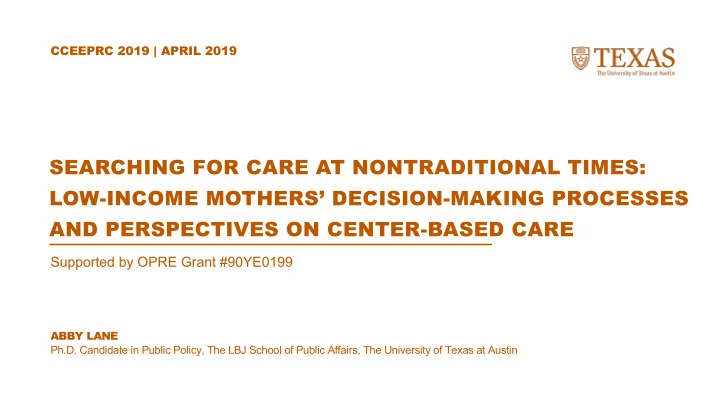

CCEEPRC 2019 | APRIL 2019 SEARCHING FOR CARE AT NONTRADITIONAL TIMES: LOW-INCOME MOTHERS’ DECISION-MAKING PROCESSES AND PERSPECTIVES ON CENTER-BASED CARE Supported by OPRE Grant #90YE0199 ABBY LANE Ph.D. Candidate in Public Policy, The LBJ School of Public Affairs, The University of Texas at Austin
Motivation • Nonstandard work hours are common among low-income parents • Child care decision-making processes are complex and dynamic – Work schedules and employment are important components • Center-based care is a key way that public policy supports families, particularly in Texas, but… – It’s not usually available at nontraditional times 2
Research Questions 1. What social, economic, and structural factors are important in child care decisions among low-income mothers working nonstandard schedules who have young children? 2. Compared to other groups of low-income mothers with nonstandard schedules, are the roles or importance of certain factors different for: a. Mothers working irregular schedules or b. Mothers with different family structures? 3. What are mothers’ perspectives on center-based child care during nontraditional hours, including its appeal and accessibility? 3
Research Methods Target sample • Low-income (<200% FPL) mothers of young children (< 6 years old) who reported working at – least one job for pay that required work at nonstandard times (outside of 8 a.m. to 6 p.m., Monday-Friday) • Recruitment Posting/distributing flyers in public and nonprofit community organizations, child care centers, – and on Craigslist Paid advertisements on Facebook – • Qualitative data collection Eligibility survey and short demographic survey – In-depth, semi-structured interviews in English – Deductive and inductive coding – 4
Sample Description • 20 mothers • Typical mom: 29-30 years old, household size 3-4 people – 55% married/cohabiting – 45% single/dating/in a relationship • Diverse by race/ethnicity • Lower-income, lower-education 5
Sample Description Mothers' Work Schedules (n = 20) Mothers' Child Care Arrangements (n = 20) 20 20 18 18 16 16 14 14 12 12 10 10 8 8 6 6 4 4 2 2 0 0 Early Weekdays Evenings Nights Weekends Irregular Other Other Daycare Home- Head Pre-K Other Parent Relative Center based Start/ Mornings Daycare EHS 6 Source: Eligibility survey, interviews Source: Demographic survey
RQ 1. Decision-making Factors SOCIAL ECONOMIC STRUCTURAL Care settings Household income Cost - Opportunities for learning Access to public programs Hours Caregiver characteristics - Personality and trust Mothers’ work schedule Availability Availability of relatives Location - Partners and extended family 7
RQ 1. Nonstandard Work Schedules “Our jobs, we have to be there • Opportunities on the weekends no matter what . So – Ability to tag-team care that’s another thing. It’s just a lot of [centers] don’t open on weekends.” • Challenges – Careful balance of work and child care “I get my schedule two days before – Matching work schedules to the first part of that schedule starts. availability and hours of So, …I have to have a babysitter operation (evenings, weekends) tomorrow. And that’s my notice… That’s a really short notice. ” – Employer-based practices 8
RQ 2. Irregular Schedules • More irregularity “I used to have a set schedule, but I would do 6 am leads to more openings and closings to 10 pm depending on the day. And that was almost easier because then I could challenges set things up… And now my position changed and so I’m picking up a lot of call-in shifts and vacation shifts. And it’s sort of expected at this point that I do that, and so, it’s almost every week that it’s a little bit different now. And it’s hard to plan ahead. ” 9
RQ 2. Family Structure • Importance of support “When you’re doing it by yourself it’s really hard. When you have a second person there system for single moms to help it makes it so much easier. Because y’all can balance…I work when you’re at home and then when I come home, you go to work. …but since we’ve been split up, it’s been really hard… I don’t have options, I don’t have four or five people who are going to come take [my] four kids… So, it makes it very difficult. ” 10
RQ 3. Center-based Care “But you have to pay the bills… • Key factors in likelihood of use: As parents, we have to provide the best life for them and so if that – Necessity means staying at work later, then – Family support system that’s just what we have to do .” – Time of day/day of week – Potential benefits “ It's a life saver. And I know like going into that place on Friday, Saturday, • Barriers to access: and Sunday, I'm not the only person using it…You have to call ahead and – Cost make a reservation, because they – Availability know they're going to be packed.” 11
Summary • Nonstandard work schedules add important challenges to the child care decision-making process: – Difficulty matching work schedules to care availability – More irregularity makes it more difficult to find and plan care – Support systems are vital • Center-based care at nontraditional times is appealing to mothers, particularly on the weekends, but cost and availability remain important barriers 12
Contact • Abby Lane: AbbyCLane@utexas.edu • This research is supported by the Office of Planning, Research and Evaluation, Administration for Children and Families, U.S. Department of Human Services (Child Care Research Scholars Grant Program, Grant #90YE0199) 13
Recommend
More recommend